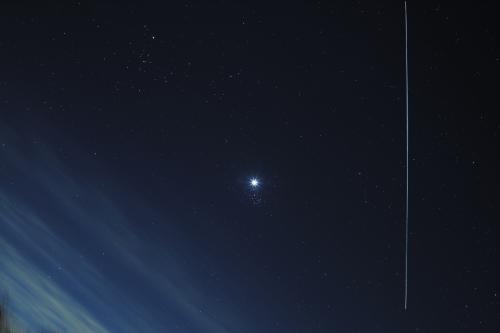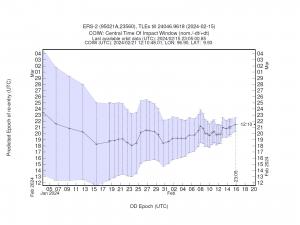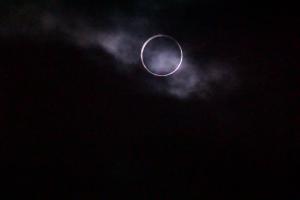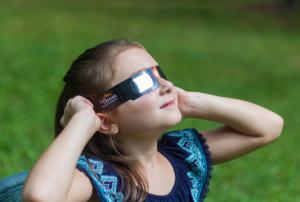Celebration of Space - February 16, 2024

Venus, the Pleiades, and the ISS in conjunction at Frosty Drew Observatory. Credit: Frosty Drew Astronomy Team member, Scott MacNeill.
Tonight, February 16, 2024, starting about 45 minutes after sunset, the first quarter Moon and the Pleiades open star cluster (Seven Sisters) will put on a stunning celestial dance as they will be in conjunction within 1.5° visibly of each other. Being that the Pleiades reside very close to the ecliptic, which is the path that the Sun takes across the sky, the Moon will often pass close to the Sisters. Being that the first quarter Moon is approaching tonight, it will not be too bright to observe the Seven Sisters nearby. Step outside this evening, after the Sun sets and before the clouds move in and see if you can spot the Moon and the Pleiades in conjunction.
In April 1995, the European Space Agency (ESA) launched an Earth observation satellite into orbit called Earth Remote Sensing Satellite (ERS-2). The satellites mission was to measure sea surface temperatures and aid in atmospheric ozone research. After a series of failures, and some very ingenious modifications, the spacecraft finally depleted its fuel on September 5, 2011. Now, almost thirteen years later, the satellite is finally coming back to Earth. But since the satellite is completely inoperable, it is a natural reentry, not a controlled reentry. At this time, we are unsure where reentry will occur, but the ESA has been tracking the satellite, and they believe reentry will occur this coming Wednesday, February 21, 2024 around 7:10 am EST. As the date approaches, a better estimate of reentry time and location will become available. Now this isn’t cause for alarm, as it is ridiculously unlikely that any part of the satellite will strike a person. Even the prospect of reentry happening over land is rather unlikely, considering the majority of Earth’s surface area is water. But there is always the chance that it happens over an area where it will become visible. If we believe there is a prospect for a visible reentry we will post about it on our Instagram. You can keep up with ESA updates regarding the ERS-2 satellite reentry. Fingers crossed for a view!
We are quite sure that you have heard, endlessly, about the coming solar eclipse on Monday, April 8, 2024, but we figured we would give you another heads up anyway. With less than two months remaining before the event, now is the time to have a finalized plan in place. In Southern New England, we will experience a 98% partial eclipse, which means that the Moon will obscure 98% of the visible area of the Sun, leaving just a thin crescent of Sun visible during maximum eclipse. This will be a spectacular view, but eclipse glasses, a camera obscura device, or a telescope fitted with a solar filter will be required to experience any part of the eclipse in Southern New England, as no part of it will be safe for the unaided eye. As for a few hours north of us, the Moon will completely obscure the Sun, creating a stunning total solar eclipse. The path of totality, which is the ground path that one would need to be along to experience a total eclipse, spans from Texas to Maine, passing through New York, Vermont, and New Hampshire. All of these are easily accessible from Southern New England. The problems that we see with the Northeast destinations come down to two things. First, the weather! April is notoriously rainy, cloudy, and muddy in the northern Northeast states. The likelihood of having a clear sky for the eclipse becomes increasingly less the further east one is on the path of totality. The second problem we see is going to be the inundation of visitors along the path of totality. Considering that the Northeast is already heavily populated, with the largest cities along the coastal regions, everyone will be heading up to the northern regions for the eclipse.
In Rhode Island, most institutions that are aligned with astronomy will likely be closed that day due to all of their staff being somewhere in the northern region to experience the total eclipse. At Frosty Drew Observatory and Science Center we will be closed for the eclipse, as all of our team will be stationed at different locations along the path of totality. We have been discussing the prospects of a live stream from multiple locations, and as the date approaches we will have more information about that possibility. It should be noted that you will not need an astronomical destination to experience the eclipse. Having eclipse glasses will be a huge bonus for observing, but a box with a hole, used as a camera obscura, will work fine as well. Even a colander will allow for a good projected view. As the date of the eclipse approaches we will put out articles and information on how to view the eclipse safely. Updates will be posted to our *no-event page. Let us know your plans for that day.
- Author:
- Scott MacNeill
- Entry Date:
- Feb 16, 2024
- Published Under:
- Scott MacNeill's Columns




